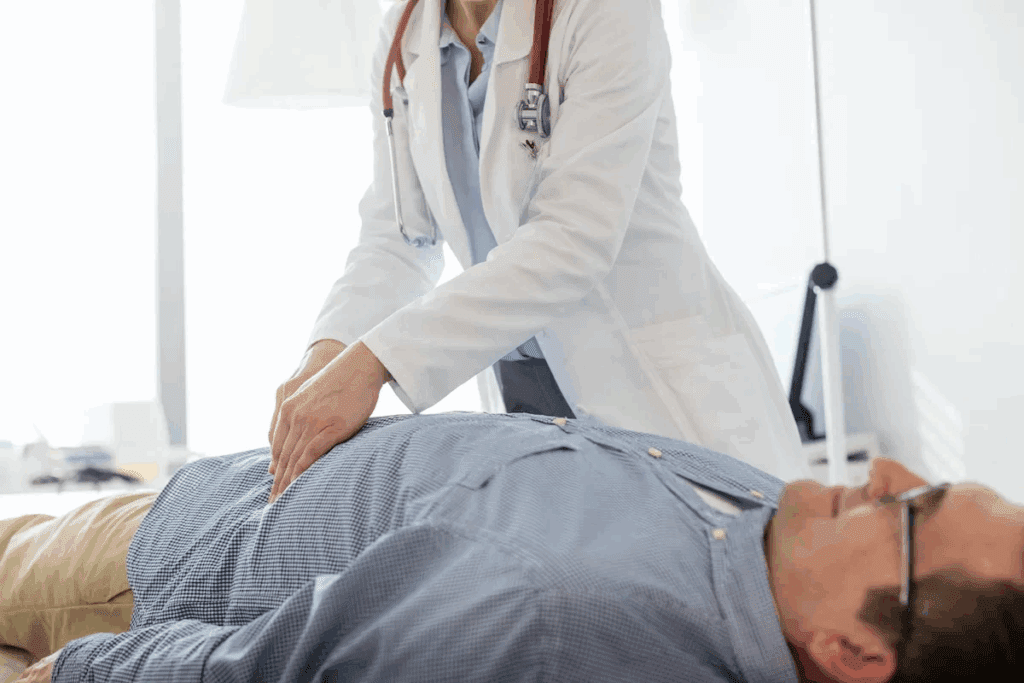Last Updated on November 26, 2025 by Bilal Hasdemir

Can u get gallstones without gallbladder? Get the shocking facts. Learn the symptoms and risks of developing post-surgery bile duct stones.
Gallstones are usually made of cholesterol. They often don’t cause any problems. But when they do, it’s key to figure out why you’re in pain. At Liv Hospital, we focus on the risks and treatment options for gallstones, even after your gallbladder is gone.

It’s important to know how gallstones form and what the gallbladder does. The gallbladder is a small organ under the liver. It plays a big role in digestion.
Gallstones are hard deposits that form in the gallbladder or bile ducts. They can be tiny or as big as a golf ball. Gallstones are usually made of cholesterol or bilirubin, a pigment from broken-down red blood cells. The exact reason for gallstone formation is complex, involving bile composition, gallbladder function, and genetics.
Gallstones often form when there’s an imbalance in bile. This imbalance can happen when there’s too much cholesterol or bilirubin. Being overweight, eating a lot of fat, and certain health conditions can increase your risk of getting gallstones.
The gallbladder stores and concentrates bile from the liver. When food reaches the small intestine, the gallbladder releases bile into the bile ducts. This bile then helps with fat digestion in the small intestine. The gallbladder’s role is key for breaking down fats into smaller parts that the body can absorb.
Even without a gallbladder, the liver keeps making bile. But without a gallbladder, bile flows constantly into the bile ducts and then into the small intestine. This can change digestion and might lead to bile duct stones or other problems.

Removing the gallbladder doesn’t mean you’re safe from gallstones. Gallstones can form in other places, like the bile ducts, even without a gallbladder.
Some people might get gallstones again after their gallbladder is removed. This is called choledocholithiasis. It happens when stones form in the bile ducts. Those who had gallstones before surgery are at a higher risk.
Choledocholithiasis is a serious issue that needs doctor care. It can cause pain and jaundice, similar to before the surgery.
Choledocholithiasis is when gallstones form in the bile ducts. This can happen even after the gallbladder is gone. The bile ducts can produce stones, causing blockages and serious problems.
The symptoms of choledocholithiasis include severe abdominal pain, jaundice, and fever. If not treated, it can lead to pancreatitis or cholangitis.
It’s important for those who had their gallbladder removed to know about choledocholithiasis. They should see a doctor if they have any symptoms that don’t go away or get worse.
After having your gallbladder removed, you might face a new risk. This is the chance of getting stones in your bile ducts. This happens because of changes in how bile flows and its composition after the gallbladder is gone.
Bile duct stones, or choledocholithiasis, occur when bile doesn’t move well or when there’s an infection in the bile ducts. The lack of a gallbladder can change how bile flows, which might cause stones to form. Doctors say, “Bile duct stones form from bile stasis, infection, and certain compounds that can turn into stones.”
“The formation of bile duct stones is a complex process involving bile stasis, bacterial infection, and the presence of certain compounds that can precipitate to form stones.”
Medical Expert
There are many reasons why bile duct stones might form. These include:
There are certain factors that can make you more likely to get gallstones after your gallbladder is removed. These include:
| Risk Factor | Description |
| Previous history of gallstones | If you had gallstones before, you’re more likely to develop them again. |
| Bile duct abnormalities | Strictures or narrowing of the bile ducts can cause bile stasis. |
| Infection | Bacterial infection within the bile ducts can contribute to stone formation. |
Knowing these risk factors is key to managing and possibly preventing gallstones after gallbladder removal. People with a history of gallstones or bile duct problems should watch closely for signs of stones.
To lower the risk of gallstones without a gallbladder, it’s important to tackle the root causes and risk factors. This might mean changing your diet, managing infections, and keeping an eye out for signs of bile duct stones.
It’s important for people who have had their gallbladder removed to know the signs of gallstones. Gallstones can form and cause problems even without a gallbladder.
Those without a gallbladder can have similar symptoms. But, the way these symptoms show up might be different. Here are some common ones:
The symptoms of gallstones without a gallbladder can be less obvious or different. Traditional gallbladder attacks are known for severe, episodic pain that comes on after eating fatty foods. Without a gallbladder, symptoms might be more ongoing or feel different because of bile duct involvement.
It’s key for both patients and doctors to understand these differences. If you’re feeling these symptoms, getting medical help is vital. They can figure out what’s wrong and how to treat it.
Untreated bile duct stones can lead to serious health problems. They can cause severe complications that need quick medical help.
The risks of untreated bile duct stones are many and can last a long time. They can lead to pancreatitis and bile duct infections, both of which are serious and can be deadly.
Untreated bile duct stones can cause pancreatitis, an inflammation of the pancreas. This can lead to severe pain, nausea, and vomiting. Pancreatitis can be mild or severe, with severe cases being life-threatening.
The symptoms of pancreatitis include:
A medical expert notes,
“Pancreatitis is a serious condition that requires prompt medical attention. Delaying treatment can lead to severe consequences.”
Bile duct infection, or cholangitis, is another serious issue from untreated bile duct stones. It happens when bacteria get into the bile duct, causing inflammation and infection. Symptoms include fever, jaundice, and abdominal pain.
Jaundice, or yellowing of the skin and eyes, is a sign of bile duct blockage. It happens when the bile duct is blocked, stopping bilirubin from being removed. Jaundice is a sign of a serious problem and needs a doctor’s check-up.
Jaundice, along with dark urine and pale stools, means there might be a bile duct blockage. This needs quick medical attention.
Diagnosing gallstones after removing the gallbladder is complex. It involves many medical tests. Without a gallbladder, finding gallstones is harder. But, stones can form in the bile ducts, called choledocholithiasis.
To find gallstones without a gallbladder, doctors use several tests. These include:
Doctors also check for other conditions that might cause similar symptoms. This is called differential diagnosis. It’s key for the right diagnosis and treatment. Conditions that might seem like gallstones include:
Getting the right diagnosis is vital for managing symptoms and avoiding serious problems. Doctors use imaging, endoscopy, and careful differential diagnosis to find and treat gallstones in patients without a gallbladder.
Gallstones can form again after the gallbladder is removed. It’s important for patients to know about the treatment options available. These stones, known as post-cholecystectomy gallstones, need quick and effective treatment to ease symptoms and avoid serious problems.
Endoscopic Retrograde Cholangiopancreatography (ERCP) is a key procedure for treating these stones. A flexible tube with a camera is inserted through the mouth to reach the bile ducts. This allows for the removal of stones or the placement of stents to help bile flow.
ERCP is a minimally invasive method that lets doctors directly see and treat bile duct stones. But, it’s important to know about the possible risks and complications, like pancreatitis, bleeding, or infection.
Medication and dissolution therapies are also used to manage these stones. Ursodeoxycholic acid (UDCA) is a medication that can dissolve certain gallstones, mainly those made of cholesterol.
Dissolution therapy is considered for those who can’t have endoscopic or surgical treatments. This method can be effective but may need long-term treatment and regular check-ups to see how well it’s working.
It’s vital for patients to talk to their healthcare provider about the benefits and risks of each treatment option. This way, they can choose the best approach for their situation.
After having your gallbladder removed, you can lower your risk of getting gallstones. The gallbladder isn’t needed to live, but its removal can change how you digest food. This can make you more likely to get stones in your bile ducts.
Making some simple changes in your diet and lifestyle can help a lot. Knowing how to prevent gallstones is key for those who have had their gallbladder taken out.
Your diet is very important in preventing gallstones after gallbladder removal. Increasing fiber intake from fruits, veggies, and whole grains helps with digestion. It also lowers the chance of getting bile duct stones. Try to reduce fat consumption, like saturated fats, as they can make bile ducts contract more.
Eating foods rich in omega-3 fatty acids, like salmon and sardines, can reduce inflammation. Drinking lots of water is also key to keep bile flowing well.
Changing your lifestyle is just as important in preventing gallstones after gallbladder removal. Regular physical activity improves digestion and helps avoid obesity, which can lead to gallstones.
Keeping a healthy weight through a balanced diet and exercise is essential. Try to avoid rapid weight loss as it can increase gallstone risk.
Long-term, regular check-ups with your doctor are important. They help catch any signs of bile duct stones or other issues early. Knowing the signs of gallstones and getting medical help quickly is very important.
By following these prevention strategies, people who have had their gallbladder removed can lower their risk of gallstones and related problems.
Gallstones without a gallbladder are a complex issue. They need a deep understanding of causes and treatments. The formation of bile duct stones after gallbladder removal is a serious complication. It can cause severe symptoms and even life-threatening conditions if not treated.
Liv Hospital is dedicated to advanced care for those with gallstones without a gallbladder. Knowing the risk factors and symptoms helps get timely medical help. This can lead to effective treatments like endoscopic procedures and medication.
People who have had their gallbladder removed should be aware of the risks. Taking preventive steps can lower the chance of gallstones without a gallbladder. This helps avoid complications and keeps the digestive system healthy.
Yes, it’s possible to get gallstones even after your gallbladder is removed. This is called choledocholithiasis.
Symptoms include stomach pain, jaundice, and fever. They might not feel like the usual gallbladder pain.
Gallstones can form in the bile ducts after your gallbladder is removed. This happens due to bile stasis and infection.
Risk factors include a history of gallstones, being overweight, and certain diets.
Doctors use medical tests and procedures like imaging studies and ERCP to diagnose gallstones.
Treatments include endoscopic procedures like ERCP and medication to dissolve stones.
While prevention isn’t guaranteed, making dietary changes and lifestyle adjustments can help lower the risk.
Untreated bile duct stones can lead to pancreatitis, infection, and jaundice. These can be serious and even life-threatening.
Eating a healthy diet, staying hydrated, and managing your weight can help prevent gallstones.
Yes, even without a gallbladder, you can experience symptoms similar to gallbladder attacks. This can be due to bile duct stones or other issues.
Yes, long-term strategies include making dietary changes, adopting a healthy lifestyle, and regular check-ups to prevent gallstones.
Subscribe to our e-newsletter to stay informed about the latest innovations in the world of health and exclusive offers!